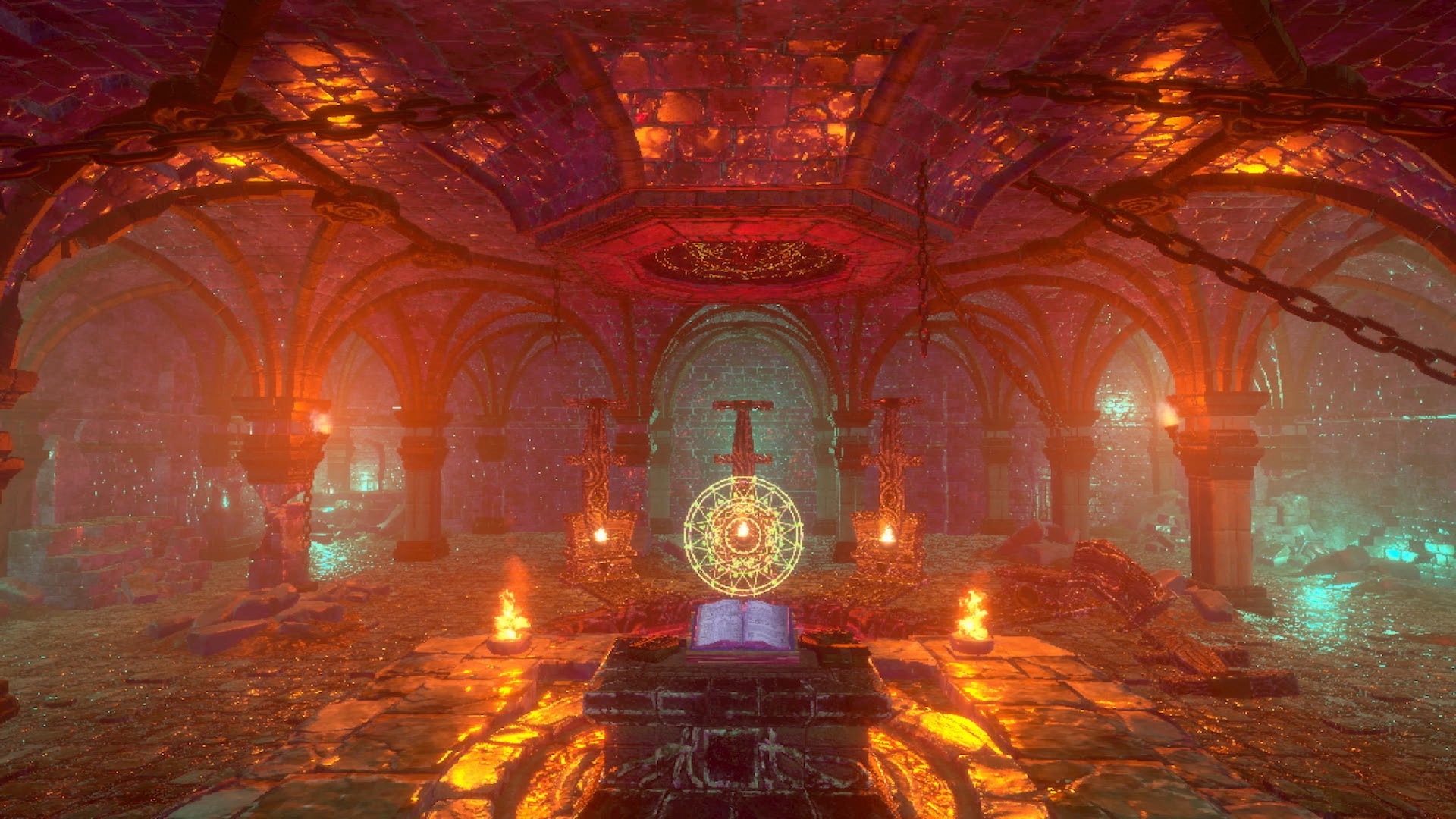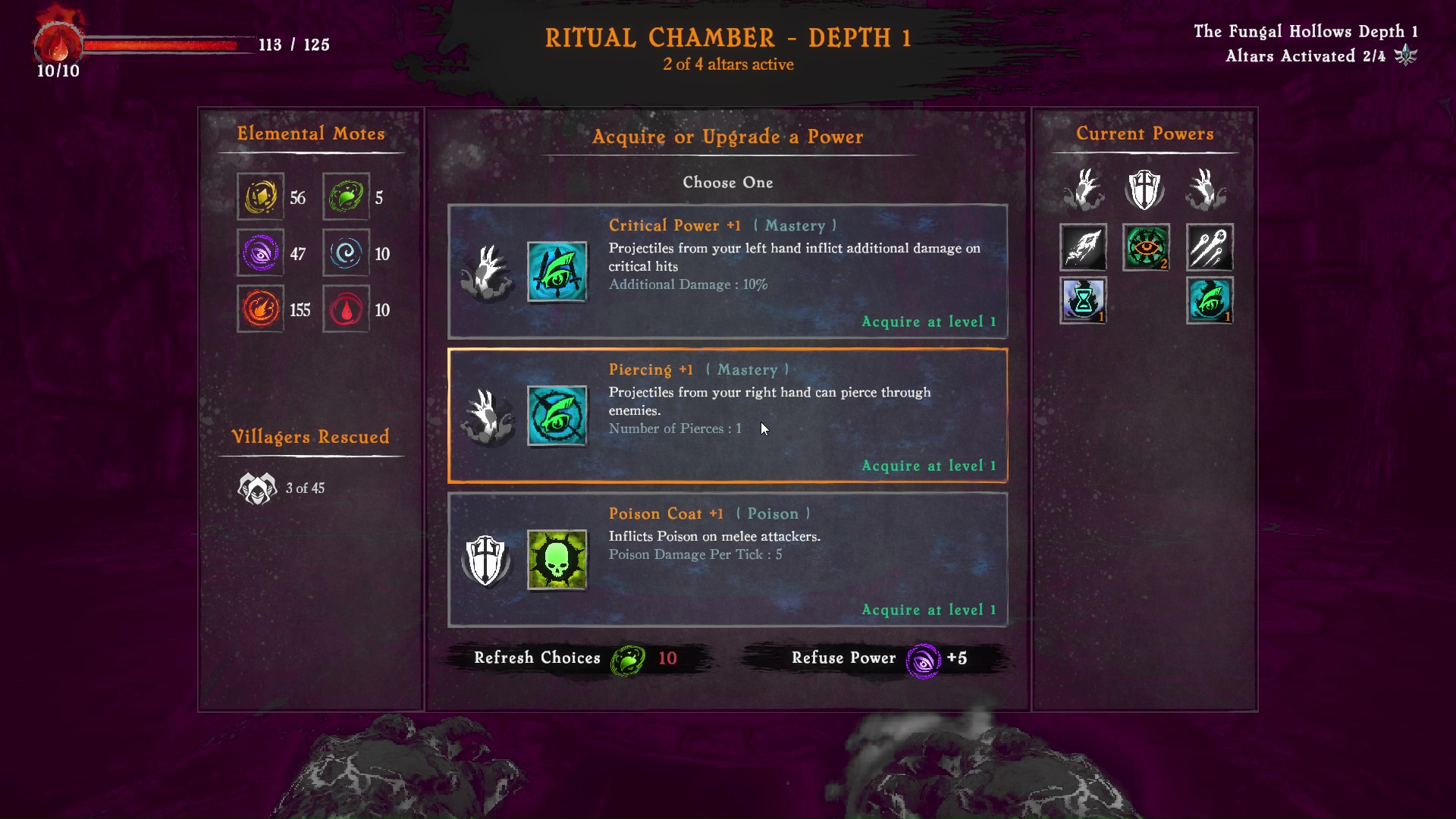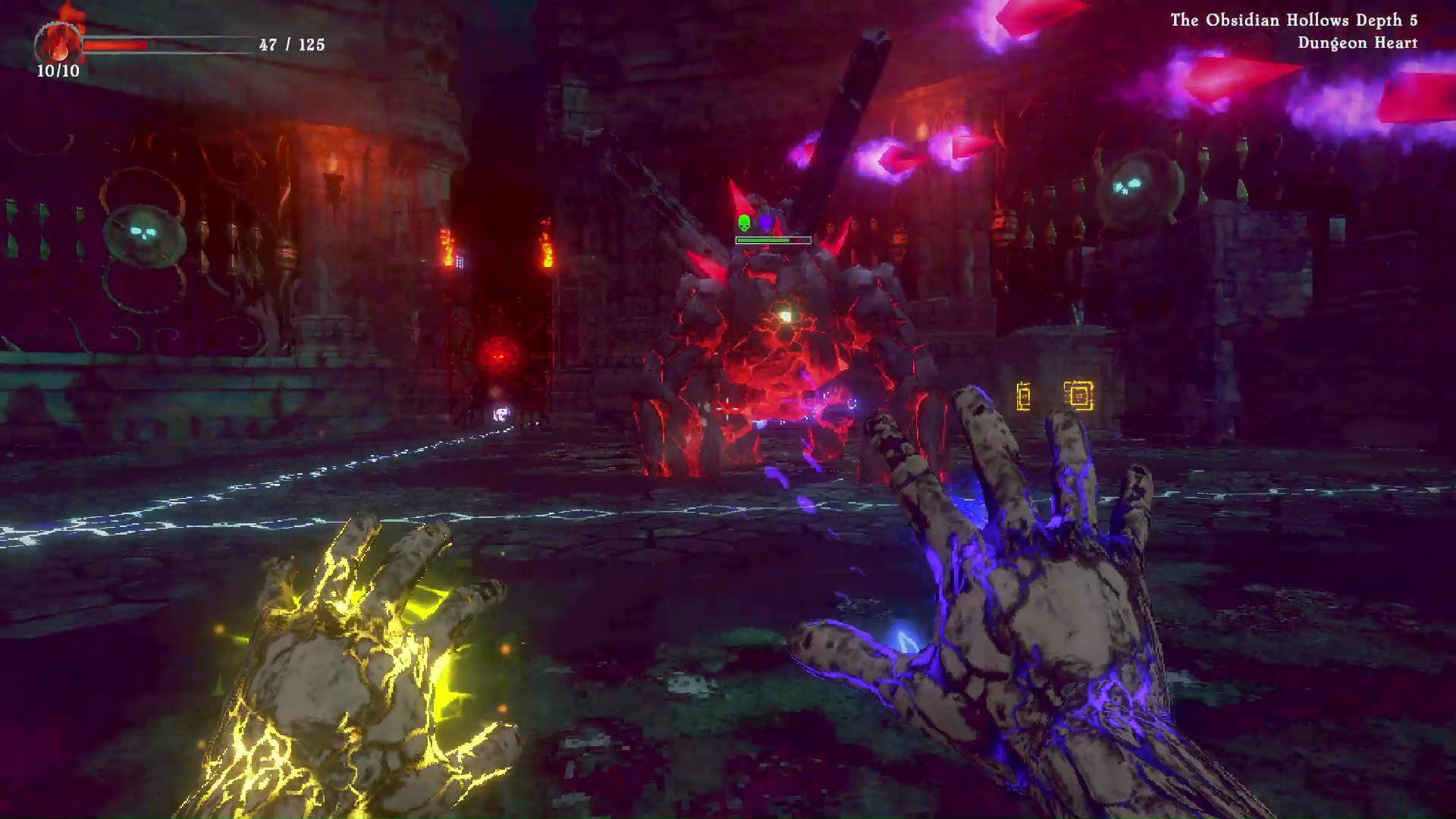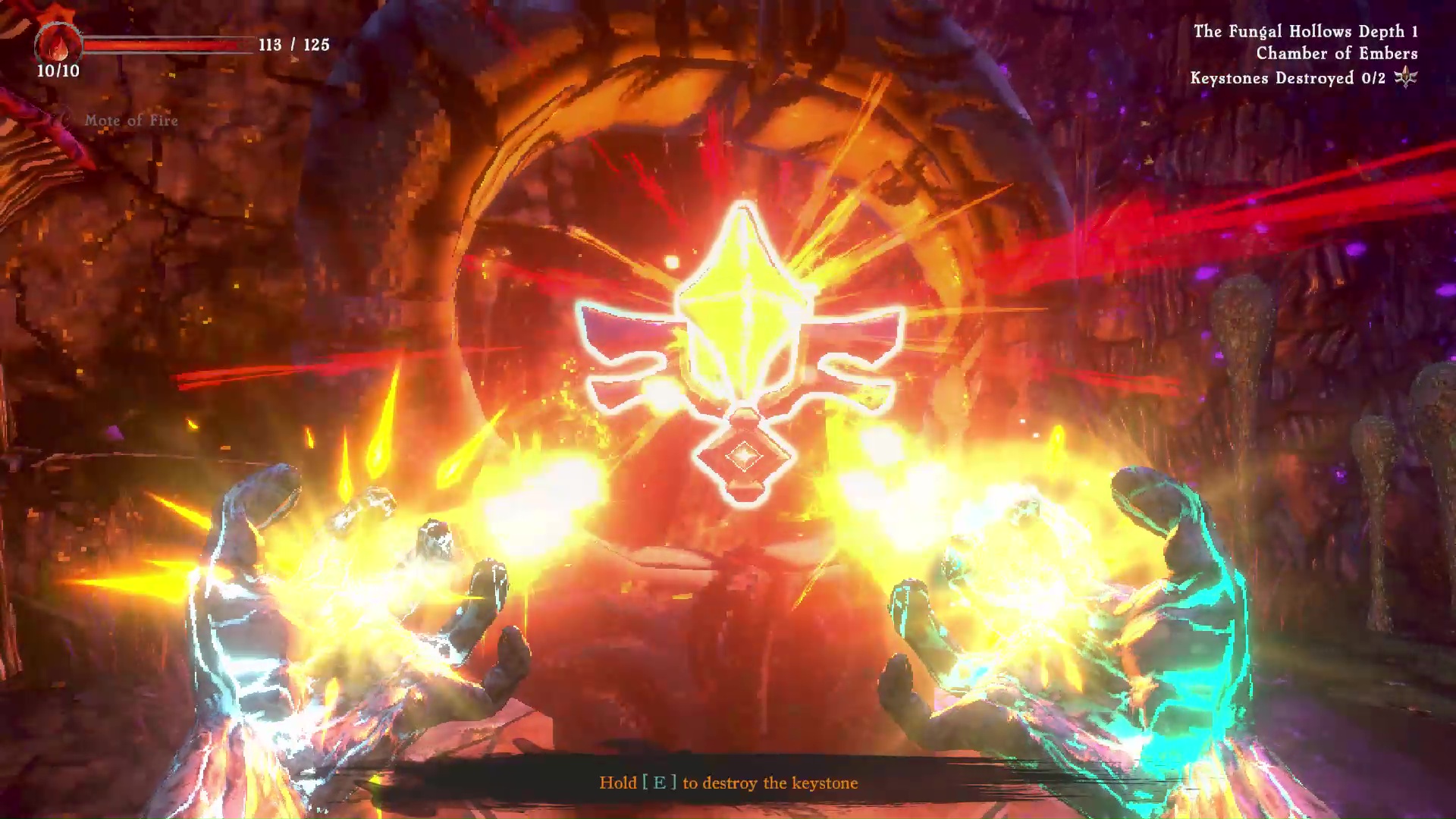I can’t deny that Into the Pit makes a good first impression. It’s got all the ingredients for a solid ’90s-style first-person shooter: it moves fast, the soundtrack’s loud and bass-heavy, and it’s metal as hell. The enemies are horrific monsters that burst pleasingly when killed, like jam sandwiches in a record press, and are varied enough to keep you guessing.
It doesn’t take that long for Into the Pit to wear out its welcome, though. It’s an interesting experiment, and I would absolutely play a more structured, traditional first-person shooter made by the same team, but it gets obnoxious fast. It’s an attempt to blend FPS action with roguelike mechanics, but the latter ends up watering down the former.
Into the Pit Review: Rocket to the Crypt
You play as a nameless traveler, who comes to an equally nameless village in search of your cousin Luridia. Both she and you are members of a family of occultists, always on the hunt for arcane lore and forbidden power, but Luridia’s letters stopped coming as soon as she found this village.
When you arrive, you find the village’s population is down to a relative handful of scared idiots hiding behind locked doors. The rest, including Luridia, have been lost to a demonic labyrinth, the Pit, that’s opened beneath the town. Armed with a handful of spells from the village’s rune-carver, you follow them in.
The good news is that magic is much easier to use in the Pit. You get to pick up to two spells, one bound to each hand, which are effectively wizard guns: you’ve got an AR-15 with burst-fire, a grenade launcher, a high-caliber hand cannon, a sniper rifle, and so on. The spell that works like a shotgun is actually called “The Shotgun.” The developers knew what they were about.
Those wizard guns are what keep you alive as you explore the randomized rooms within the Pit. Each room is a monster closet, full of keystones to destroy, demons to fight, and resources to collect. Destroy enough keystones, and you’ll eventually unlock the path to go deeper into the current dungeon.
Part of the ritual that opens the Pit involves the use of at least one gem, which determines which area within the Pit you’ll visit on a run, such as a rotting swamp, haunted forest, or standard stone labyrinth. Each of those areas has a few villagers of its own for you to rescue, and the more of them you find, the more services become available back at the village.
One neat rule is that once you have more than one gem, you can install a couple at once to open up a new dungeon that fuses together two of the others, mixing up their monsters and architecture.
Now the harbor isn’t just rusty, disgusting, and full of homicidal crabs; it’s also poisonous. The swamp harbor still has a few villagers to rescue inside it, though, so you have to go no matter how bad an idea it is.
Each time you clear a room, you’re offered a shot at one of three new passive bonuses, which can include status ailments, damage buffs, or a speed boost. None of them really change the gameplay significantly — your weapon choice at the start of a run does more to determine how you play than anything you’ll subsequently pick up — but you do end up feeling measurably more powerful as you stack up bonuses.
All of them go away at the end of a run, however, whether you die or defeat the boss that’s found at the bottom of the dungeon. It’s complicated, and Into the Pit doesn’t explain its mechanics particularly well, but it’s easy enough to pick up as you go.
If the game does one thing right, it’s the combat. Into the Pit feels, and to some extent looks, like a shooter from about 1998. Your character, without any bonuses or buffs, is still the fastest thing on the battlefield, with a usefully floaty jump.
Your best asset in any fight is your sheer mobility, as you can run circles around any of the demons that Into the Pit throws at you. Into the Pit is at its best when you’re moving at a dead sprint, dodging around the army of demons that are hot on your heels, and picking them off two and three at a time.
That does set up a weird imbalance, however, where the actual bosses might be the least threatening part. Into the Pit is at its hardest when it’s a battle of attrition, before you’ve found any of the runes or skills that enable you to regain health, and every incidental hit you take from some random demon is a big resource loss.
The bosses, on the other hand, are big, slow goons that you can virtually dance around. Sure, they hit like freight trains, but I’d rather fight them than half of the standard demons.
Going Rogue
If Into the Pit was just a fast-moving throwback shooter like Dusk, I’d happily recommend it. The problem is that it’s also a roguelike — or it’s trying to be.
The rooms in each dungeon are theoretically random, but they’re not procedurally generated. They’re a bunch of pre-made maps with enemies placed inside them, and it doesn’t take long before they start repeating.
While a few of the maps and their associated hazards do seem like they’re exclusive to one particular dungeon or another, it’s not unusual to see the same map twice in a single run.
You also don’t really evolve your strategy in Into the Pit. Part of the challenge and appeal of a modern roguelike is in being forced to put together an arsenal on the fly, assembling the random skills, treasures, and consumables you’re given into a winning game plan.
Here, your game plan is effectively set in stone the moment you pick your two “guns” at the start of a run into the Pit. Everything you find from that point forward is strictly about damage: dealing it, withstanding it, recovering from it.
You won’t find new guns with unusual effects, big buffs that come with significant drawbacks, or game-changing new features like, say, a melee weapon or the ability to see/shoot through walls.
All you get is slight buffs to what you’re already capable of at the start, which turns a given trip through the Pit into a raw test of twitch reflexes.
There is a certain amount of challenge to that early on before you have a lot of ways to heal. Every hit you take at that point is potentially lethal, with no guarantee you’ll be able to recover before the boss. It gives Into the Pit a unique tension.
You can pick up cheap new runes that give slight regeneration effects, however, which restore points of health whenever you grab resources or destroy a keystone. Once you install those, and maybe the passive skill that gives you some health for each demon you splatter, Into the Pit loses most of its challenge. I’d go so far as to suggest you avoid those runes if you really want to keep the game interesting for yourself.
Into the Pit Review — The Bottom Line
Pros:
- It’s basically an interactive Iron Maiden album cover
- Very fast
- Your character’s incredibly agile, which is fun
- Not a lot of plot to get in the way of the action
- The combat does flow well once you get a handle on it
Cons:
- The roguelike mechanics detract more than they add
- It’s impossible for any single level to get up a good head of steam
- Insanely repetitive
- Crashes a lot
- Dodgy collision detection, particularly in the swamp level
I could nitpick some more, but at the end of the day, I think my biggest problem with Into the Pit comes down to pacing.
Its fights are fun, fast, and hyperkinetic, but because of how the game is built, they’re all over in two minutes or less. No single room in the Pit holds more than about 20 demons, and even near the start of a run, most of them are glass cannons. They’re placed to wear you down through attrition, rather than pose a genuine one-on-one threat.
If Into the Pit‘s random rooms were paced more like combat arenas in other games, it’d be amazing despite its flaws. As it is, even the well-built rooms feel like they’re over before they get started, with little thought given to issues like enemy placement or individual AI.
It’s possible I’m coming at this from a skewed perspective at the moment, because I’ve been playing a lot of twitchy first-person shooters in my free time, like the aforementioned Dusk. I was in exactly the right mood for another game in exactly that vein. Into the Pit looked like it’d fit the bill, but it doesn’t quite work; its roguelike elements make up most of the game, and they’re more annoying than truly worthwhile.
[Note: Humble Games provided the copy of Into the Pit used for this review.]










Published: Nov 11, 2021 02:54 am